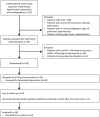Acute effects of aerosolized iloprost in COPD related pulmonary hypertension - a randomized controlled crossover trial
- PMID: 23300624
- PMCID: PMC3531427
- DOI: 10.1371/journal.pone.0052248
Acute effects of aerosolized iloprost in COPD related pulmonary hypertension - a randomized controlled crossover trial
Abstract
Background: Inhaled iloprost potentially improves hemodynamics and gas exchange in patients with chronic obstructive pulmonary disease (COPD) and secondary pulmonary hypertension (PH).
Objectives: To evaluate acute effects of aerosolized iloprost in patients with COPD-associated PH.
Methods: A randomized, double blind, crossover study was conducted in 16 COPD patients with invasively confirmed PH in a single tertiary care center. Each patient received a single dose of 10 µg iloprost (low dose), 20 µg iloprost (high dose) and placebo during distinct study-visits. The primary end-point of the study was exercise capacity as assessed by the six minute walking distance.
Results: Both iloprost doses failed to improve six-minute walking distance (p = 0.36). Low dose iloprost (estimated difference of the means -1.0%, p = 0.035) as well as high dose iloprost (-2.2%, p<0.001) significantly impaired oxygenation at rest. Peak oxygen consumption and carbon dioxide production differed significantly over the three study days (p = 0.002 and p = 0.003, accordingly). As compared to placebo, low dose iloprost was associated with reduced peak oxygen consumption (-76 ml/min, p = 0.002), elevated partial pressure of carbon dioxide (0.27 kPa, p = 0.040) and impaired ventilation during exercise (-3.0l/min, p<0.001).
Conclusions: Improvement of the exercise capacity after iloprost inhalation in patients with COPD-associated mild to moderate PH is very unlikely.
Trial registration: Controlled-Trials.com ISRCTN61661881.
Conflict of interest statement
Figures


References
-
- Mannino DM (2002) COPD: epidemiology, prevalence, morbidity and mortality, and disease heterogeneity. Chest 121: 121S–126S. - PubMed
-
- Kessler R, Faller M, Fourgaut G, Mennecier B, Weitzenblum E (1999) Predictive factors of hospitalization for acute exacerbation in a series of 64 patients with chronic obstructive pulmonary disease. Am J Respir Crit Care Med 159: 158–164. - PubMed
-
- Oswald-Mammosser M, Weitzenblum E, Quoix E, Moser G, Chaouat A, et al. (1995) Prognostic factors in COPD patients receiving long-term oxygen therapy. Importance of pulmonary artery pressure. Chest 107: 1193–1198. - PubMed
-
- Bogaard HJ, Dekker BM, Arntzen BW, Woltjer HH, van Keimpema AR, et al. (1998) The haemodynamic response to exercise in chronic obstructive pulmonary disease: assessment by impedance cardiography. Eur Respir J 12: 374–379. - PubMed
Publication types
MeSH terms
Substances
Associated data
LinkOut - more resources
Full Text Sources
Other Literature Sources
Medical
Research Materials

